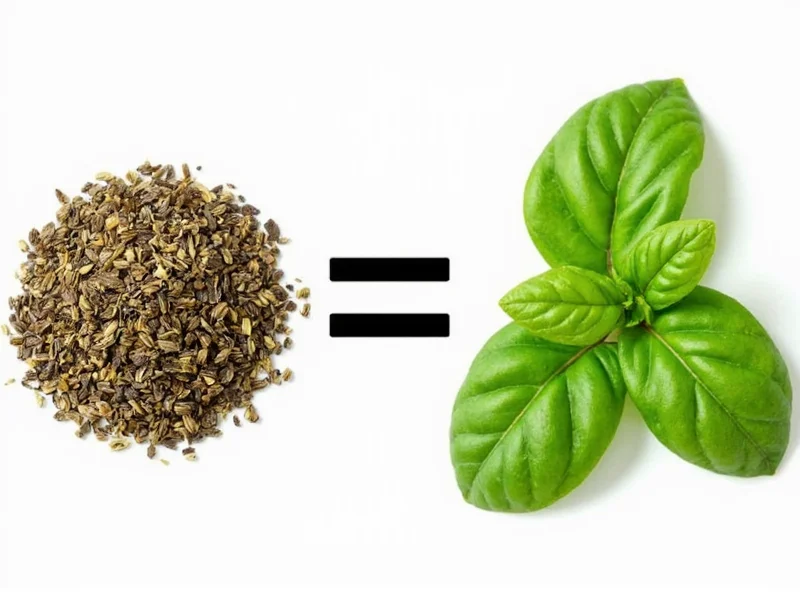Understanding herb conversions is essential for consistent cooking results. When substituting dried basil for fresh in recipes, the standard measurement conversion follows a simple rule: dried herbs are typically three times more potent than their fresh counterparts. This means you need less dried basil to achieve a similar flavor profile.
Why the 1:3 Dried to Fresh Basil Conversion Ratio Works
The science behind this conversion lies in the dehydration process. Fresh basil contains approximately 90% water, which evaporates during drying. As water removes, the concentrated essential oils and flavor compounds become more potent. Culinary experts and food scientists confirm that most herbs undergo this threefold concentration when dried.
When you're converting fresh basil to dried measurements for cooking, remember that dried herbs have more intense flavor but less brightness than fresh varieties. The volatile oils that give fresh basil its characteristic aroma partially dissipate during drying, resulting in a more earthy, concentrated flavor profile.
Practical Conversion Guide for Cooking
For precise recipe adaptation, use this comprehensive conversion reference. Whether you're substituting dried basil for fresh in pasta recipes or adjusting measurements for soups and sauces, these ratios ensure consistent results:
| Measurement | Fresh Basil | Dried Basil |
|---|---|---|
| Teaspoon | 3 tsp | 1 tsp |
| Tablespoon | 1 tbsp | 1 tsp |
| Cup | 1 cup | 1/3 cup |
| Ounce | 1 oz | 1/3 oz |
Expert Tips for Successful Basil Substitution
While the 1:3 ratio provides a solid foundation, several factors affect how you should adjust dried basil measurements in recipes:
- Add dried herbs earlier: Incorporate dried basil at the beginning of cooking to allow time for rehydration and flavor development, unlike fresh basil which you typically add near the end
- Consider recipe type: For tomato-based sauces and slow-cooked dishes, use the full 1:3 ratio. For delicate dishes like salads or garnishes, consider using slightly less dried basil
- Taste as you go: Dried herb potency varies based on age and storage conditions. Always taste before final seasoning
- Reconstitute when possible: For applications where fresh texture matters, try mixing dried basil with a small amount of warm water or olive oil before adding to your dish
Understanding Flavor Differences Between Fresh and Dried Basil
Fresh and dried basil offer distinct culinary experiences beyond simple measurement conversion. Fresh basil provides bright, sweet notes with hints of anise and pepper, while dried basil develops deeper, more earthy characteristics with subtle mint undertones.
Professional chefs note that dried basil substitution ratios for Italian cooking might need slight adjustments depending on the specific dish. For pesto or caprese salad, fresh basil remains irreplaceable. However, for marinara sauces, soups, and stews, properly measured dried basil works beautifully.
Storage Tips to Maintain Basil Quality
Maximize the shelf life and potency of your herbs with these storage recommendations:
- Store dried basil in an airtight container away from light and heat
- Replace dried herbs every 6-12 months for optimal flavor (they don't spoil but lose potency)
- Keep fresh basil stems in water at room temperature (refrigeration damages the leaves)
- Freeze fresh basil in olive oil for longer preservation while maintaining flavor
When Precision Matters Most
Certain recipes demand more precise herb measurements than others. Understanding how much dried basil replaces fresh in specific dishes can make the difference between success and disappointment:
- Pasta sauces: Use the full 1:3 ratio as the long cooking time allows dried basil to fully rehydrate
- Soups and stews: Consider using 25% less dried basil than the conversion suggests, as prolonged cooking intensifies flavors
- Baked goods: Follow the 1:3 ratio precisely, as baking creates concentrated flavors
- Vinaigrettes and dressings: Use slightly less dried basil (about 25% less than the conversion) as the oil extracts maximum flavor
Common Mistakes to Avoid When Substituting Basil
Even with the correct conversion ratio, these pitfalls can compromise your dish:
- Adding dried basil at the same stage as fresh (dried needs time to rehydrate)
- Not accounting for the age of dried herbs (older herbs lose potency)
- Using the same texture expectations (dried basil won't provide the same visual appeal)
- Overcompensating for perceived flavor weakness by adding too much











 浙公网安备
33010002000092号
浙公网安备
33010002000092号 浙B2-20120091-4
浙B2-20120091-4